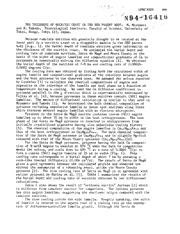
NASA Technical Reports Server (NTRS) 19940011943: The thickness of eucritic crust in the HED parent body PDF
Preview NASA Technical Reports Server (NTRS) 19940011943: The thickness of eucritic crust in the HED parent body
j LPSC XXIV 999 / ' J/ '/ , /N 9 G4 1 b THE THICKNESS OF EUCRITIC CRUST IN THE HED PARENT BODY; M. Miyamoto _ _,) and H. Takeda, Mineralogical Institute, Faculty of Science, University of ," _ Tokyo, Hongo, Tokyo 113, Japan. Because cumulate eucrites are generally thought to be located at the lower part in a eucritic crust on a diogenitic mantle in the HED parent body [e.g., i], the burial depth of cumulate eucrites gives information on the thickness of the eucritic crust. We estimated the burial depth and cooling rate of cumulate eucrites, Serra de Mag_ and Moore County on the basis of the width of augite lamellae and compositional gradients of Ca in pyroxenes by numerically solving the diffusion equation [2]. We obtained the burial depth of the eucrites of 7-8 km and cooling rate of 0.00016- 0.0002 degrees C/yr. The cooling rate was obtained by fitting both the calculated width of augite lamella and compositional gradients at the interface between augite and the host pyroxene to the observed ones. We assumed the solvus reported by Lindsley [3] to calculate the chemical compositions of augite and pigeonite at the interface of the lamella and host phase as a function of temperature during a cooling. We used the Ca diffusion coefficient in pyroxene parallel to the _ direction which is experimentally determined by Fujino et al. [4], because pyroxenes in these eucrites contain (001) augite lamellae. The method of diffusional calculation is similar to that used in Miyamoto and Takeda [2]. We determined the bulk chemical composition of pyroxene including exsolution lamella by dense spot analyses along lines which traverse several augite lamellae with an electron microprobe. Pyroxene in the Serra de Mag_ eucrite contains coarse (OO1) augite lamellae up to about 35 _m in width in the host orthopyroxene. The host phase of the Serra de Mag_ pyroxene is inverted to orthopyroxene from initially crystallized pigeonite during slow subsolidus cooling history [5]. The chemical composition of the augite lameUae is Ca_iMg_0Fe19 and that of the host orthopyroxene is Ca2Mgs_Fe_. The bulk chemical composi- tion of the Serra de Mag_ pyroxene is CasMgs2Fe_0 and is slightly Mg-rich compared with that of the Moore County pyroxene (Ca10Mg_6Fe_)[6]. For the Serra de Mag_ pyroxene, pyroxene having the bulk Ca composi- o tion of 8 mol% begins to exsolve at 970 C when the bulk Ca comDosition meets the solvus, and cools down to 600 °C at a rate of 0.0002 °C/yr to form a coarse (001) augite lamella of 35 _m in width (Fig. i). This cooling rate corresponds to a burial depth of about 7 km by assuming a rock-like thermal diffusivity (0.004 cmZ/s). The result of Serra de Mag_ gives a good agreement between the calculated profile and observed one without the assumption of a reheating event, unlike the Moore County pyroxene [2]. The slow cooling rate of Serra de Mag_ is in agreement with earlier proposal by Harlow et al. [5]. Table 1 summarizes the results of the burial depth and cooling rate of eucrites obtained by our diffusional calculations. Table 1 also shows the result of "ordinary eucrite" Juvinas [i] which is different from cumulate eucrite for comparison. The Juvinas pyroxene has thin augite lamellae, suggesting the shallower origin compared with the cumulate eucrites. The slow cooling yields the wide lamella. Roughly speaking, the width of lamella is inverse to the square root of a cooling rate on the assump- tion of diffusion-controlled lamella growth. Although the Serra de lO00 LPSC XXIV THICKNESS OF EUCRITIC CRUST: Miyamoto M. and Takeda H. Mag_ pyroxene has augite lamella of 35 _m in width much narrower than the Moore County pyroxene ilO0 Wm), the cooling rate obtained for the Serra de Mag_ pyroxene (0.0002 VC/yr) is a small value which is similar to that for the Moore County pyroxene (0.00016 °C/yr). This slow cooling of Serra de Mag_ despite thin augite lamella compared with Moore County is mainly due to the bulk Ca content of the Serra de Mag_ pyroxene (8 mol%) lower than that of the Moore County pyroxene (I0 mo1%)[6]. According to the results of our calculations of the Serra de Mag_ and Moore County eucrites which have relatively wide augite lamellae among eucrites, the thickness of a eucritic crust in the HED parent body is estimated to be about I0 km. We thank Drs. M. Prinz and G. E. Harlow for the meteorite samples. References: [I] Takeda H. (1979) Icarus_ 40, 455. [2] Miyamoto M. and Takeda H. (1992) Lunar Planet. Sci. XXIII, 921. [3] Lindsley D. H. (1983) Amer. Mineral. r 68, 477-493. [4] Fujino K., Naohara H., and Momoi H. (1990) EOS_ 71, 943. [5] Harlow G. E., Nehru C. E., Prinz M., Taylor G. J. and Keil K. (1979) Earth Planet. Sci. Lett._ 43, 173. [6] Hess H. H. and Henderson E. P. (1949) Amer. Mineral. t 34, 494. Table 1. The burial depth and cooling rate of eucrites obtained by our diffusional calculation. Aug. lamella Burial Cooling Bulk Ca content Sample width(_m) depth(km) rate(°C/yr) of pyroxene(mol%) Serra de Mage _ 35 7 0.0002 8 Moore County _ i00 8 0.00016 lO_ Juvinas _ 3 0.5 0.05 12 Cumulate eucrite; + Ordinary eucrite. _ Hess & Henderson [6] 5O Serra de Mag Fig. 1. Ca compositional profiles for augite and __.40 970--> 600°C Aug orthopyroxene in the Serra de Mage eucrite. 0.0002 °C/yr 2 Open circles show an E 30 observed profile at the 0 interval of 1 _m. The origin is the center "_ of augite lamella. _ 20 Solid line shows the 0 calculated profile by a cooling from 970 to 600 10 Opx °C. 0 0 10 20 3O 4O 5O Distance
